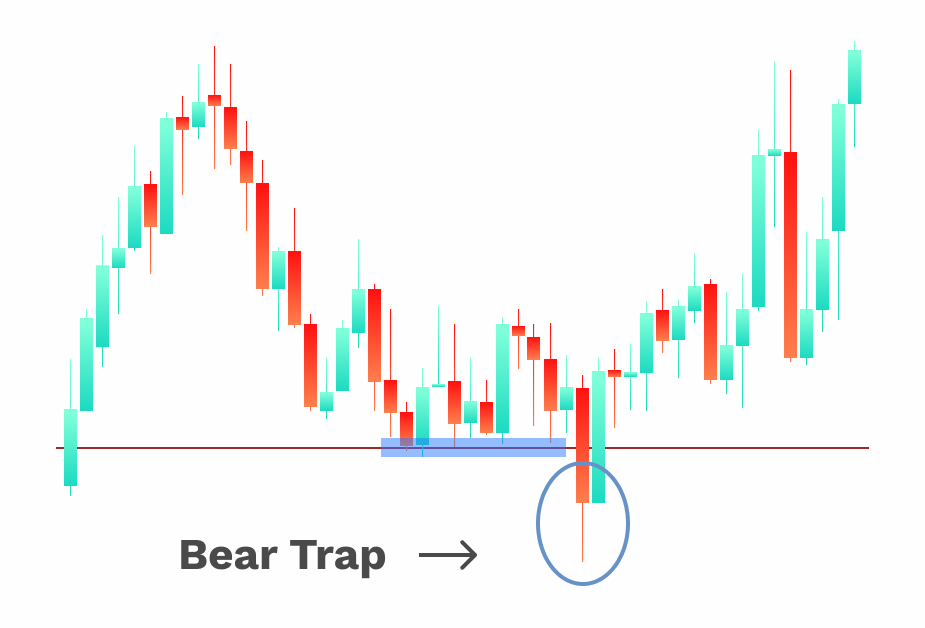
Lately, we have published many articles on market signals and chart patterns. Probably, you have read about such patterns as a bear pennant, evening star pattern, or some other trend reversal indicators. This article is a bit different. We will speak about the trading mistake so common that it got its own name! This tech pattern is called a “bear trap.”
This pattern promises you the soon ending of the uptrend, but instead of a trend reversal, the uptrend continues. If you short some crypto, you should beware of such patterns to avoid mistakes that can be fatal for your investments. Read this article in full to learn how to identify a bear trap, how it works, what consequences you can face if you ignore it if there is a bull trap, etc.
What Is a Bear Trap?
A bear trap is a candlestick chart pattern characterized by a false reversal signal in the uptrend. Investors hoping to profit from selling assets before they fall in price (bears) will post short positions as a reaction to a bearish trend reversal. The reason is that they trust a false signal and believe that the prices are soon to fall. But instead, after a slight decline, the price resurges and goes even higher than before, leaving bears with losses.

Bears and Bulls
Bears and bulls are essential terms in the vocabulary of traders and investors. Traders and investors who believe that a given asset will lose its value soon and act respectively are called bears. Bulls believe that an asset of interest will gain value. Bears are bearish, and bulls are bullish.
Bears are shorting an asset (selling it) as they believe they are selling it at a high price, and its price will only go lower in the future. Later, bears will be able to repurchase it at a lower price. Many bears amplify returns using borrowed assets. This type of trading is called margin trading and has multiple nuances.
Bulls believing that the asset price will keep growing are eager to buy an asset before the price has increased significantly. If not mistaken, they can sell the asset later when its price surges.
The uptrend is called a bull market, and the bear market is another way to say “downtrend.” Bearish signals are the chart patterns indicating the soon ending of the uptrend, while bullish signals are quite the opposite — they point to the soon reversal from the downtrend to an uptrend.
How Bear Traps Work?
Bear traps occur regardless of the assets you trade and go in many forms. For instance, it can turn out to be a standard correction occurring amidst the bull market. Telling if the correction will continue or end up being a bear trap is almost impossible, especially for inexperienced traders. Nevertheless, you can learn to protect your investments from bear traps. We’ll speak about it in the next chapter. But first, we will focus on how traders get into bear traps.
There are two general types of bear traps. The bear trap can occur during the correction period during the uptrend or as a short reversal that reverses back to an uptrend. Both types of bear traps fit the general description: in the uptrend, the selling sentiment begins to win, but soon bulls regain their positions, and the price continues to grow, reaching new heights.
Impatient bears can think that the trend will reverse, and it’s time to post short positions to sell the asset as soon as possible. They believe that the asset’s price will keep declining in the near future, so they hurry to get rid of the asset without hesitation. But instead of watching the price of this asset meltdown, creating a perfect repurchase opportunity, they are facing an unexpected resurgence of the asset, meaning that they sold their coins too early and lost their investment and potential profits.
They can repurchase the funds they have sold but will have to spend more money than they have received to sell the asset. Alternatively, bad-luck traders can wait for a new downtrend. It may take days or even months.
How To Avoid Bear Trap in Crypto Trading?
If the decline period lasts for a significant amount of time, bears might think the downtrend is almost there, and it is time to post short positions. The short positions grow up, making other bears believe the price will drop soon. However, the price bounces back after touching the support level. Bullish buyers see a buying opportunity (lower price) and post long positions reversing the bearish microtrend. The price starts to grow rapidly, leaving bears without profit.
To avoid a bear trap, you should learn to identify it early on. As the prices start to grow, short sellers have to close their positions not to lose much. This moment when bears cover positions and bulls increasingly buy the asset is the switch point where bears can minimize their losses and prevent losing all in a bear trap.
In many cases, fundamentals are to blame for the emergence of bear traps. The tech analysis can indicate a decent uptrend, but then the news hits in and creates a price decline for a while. For instance, news about the company behind the asset can make people doubt and trigger a temporary price decline. So it’s better to check the news feed if you see a sudden price decline, not confirmed by tech indicators. Probably, you are dealing with a bear trap. Use tech indicators (e.g., RSI) to exclude a bear trap. Candlestick patterns play the same role. They can confirm or disprove the upcoming trend reversal. Bearish engulfing, evening star and other patterns can help you to predict if the uptrend is about to finish.
Other tips include paying attention to a trading volume and using stop orders. If you see that the trading volume is not that big, it can be interpreted that the forming bearish reversal is a short-term correction, and soon bulls will dominate again. As for stop orders, you can protect your funds from high losses, as your short positions will automatically terminate if the price goes in the wrong direction.
Finally, to minimize losses, you can jump in the bulls wagon for a while and post long positions before the price gets too high. You will sell off an asset later and get good returns.
Bull Trap
As you have probably guessed, a bear trap is mirrored by a bull trap, a pattern in the downtrend that lures bulls with a false bullish signal. Bulls see that an asset of interest begins to gain price and rush to invest in it as long as it is relatively cheap. They think the asset will soon become more expensive, so that they will sell it at a high price.
However, what happens next is quite the opposite of what they expect. The price stops to gain price and goes down, leaving all impatient bulls with an asset they have just bought at an inadequately high price.
As you can see, a bull trap is a kind of inverted bear trap. The logic behind the notion is very similar.
Conclusion
Now, let’s recap everything we have told you above. Bear trap takes place in an uptrend and looks like a trend reversal formation. Bears activate and post short positions, but soon buyers push harder, and the uptrend continues leaving bears without profits and even causing severe damages.
Often bear traps sort of contradict the forecasts based on tech analysis as they are triggered by some news. That’s why tech analysis can be more reliable than fundamentals. Of course, it’s better to combine these tools.
To avoid bear traps, you should pay attention to unexpected price changes that contradict the tech indicators. If the trading volume is low, the chances of an actual trend reversal are negligible. You can always protect your investment using stop orders, other candlestick patterns, tech indicators, and posting long positions when necessary.
Related
Stay tuned
Subscribe for weekly updates from our blog. Promise you will not get emails any more often.
Most Popular
New Posts
Stay tuned
Subscribe for weekly updates from our blog. Promise you will not get emails any more often.







